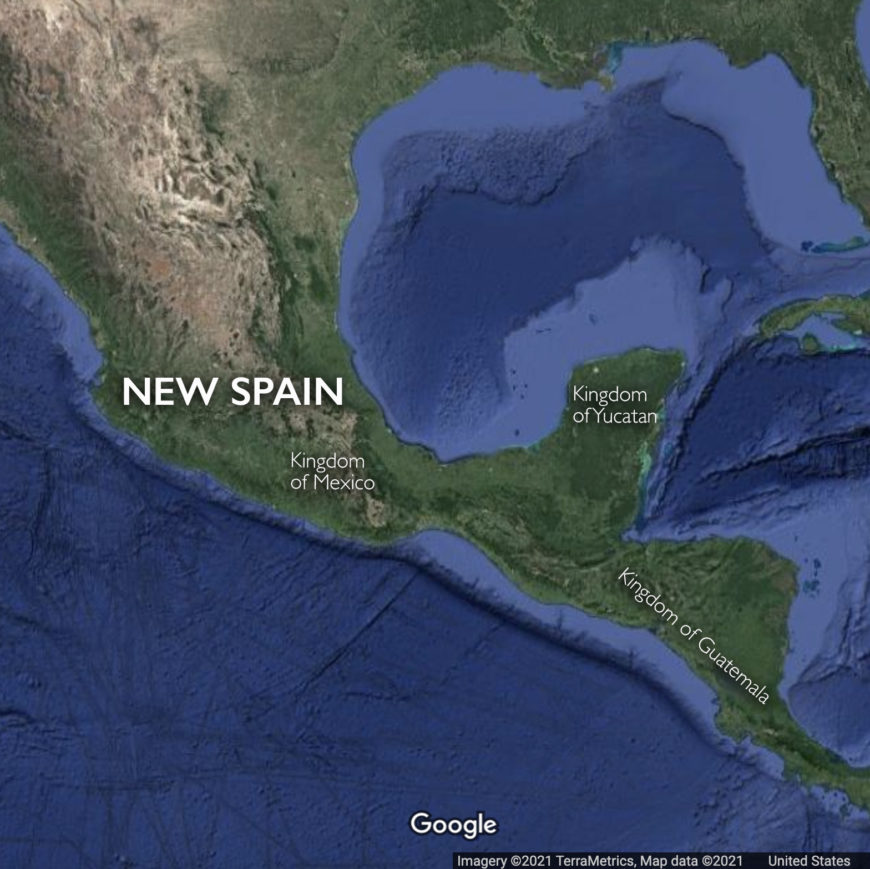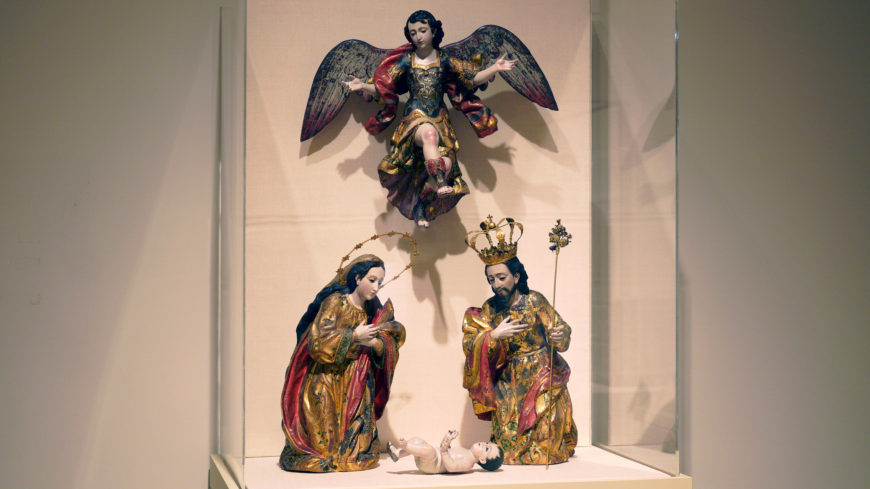
Nativity, 18th century, Guatemala, polychromed wood, gilt silver, glass, Jesus 24.4 cm, Angel 45.7 cm, Mary 50.8 cm, Joseph 52.7 cm (The Metropolitan Museum of Art; photo: Steven Zucker, CC BY-NC-SA 2.0)
Mary and Joseph kneel before the Christ Child, who rests on his back with his legs and arms tucked up—as newborns are prone to do. Both parents look down reverently at the child. An elaborate, delicate golden halo encircles Mary’s head, whereas Joseph has a golden crown resting on his. Hovering above the family is the archangel Gabriel, his wings and arms outstretched in a gesture of presentation and protection, as if to call attention to the birth of the son of God and to signal his defense of him.
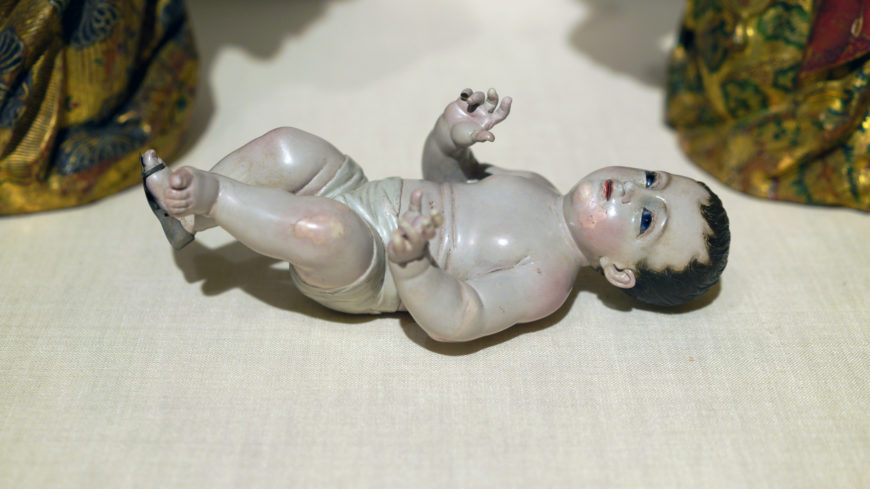
The Christ Child in the Nativity, 18th century, Guatemala, polychromed wood, gilt silver, glass, 24.4 cm (The Metropolitan Museum of Art; photo: Steven Zucker, CC BY-NC-SA 2.0)
These four delicately carved, painted, and gilded figures form the Nativity, the occasion of the birth of Jesus Christ. Currently unknown artists produced them in 18th-century Guatemala, which at this time was part of the Spanish viceroyalty of New Spain after these Maya lands had been invaded and waves of conquests had begun in 1524. The country of Guatemala today was then part of the Audiencia of Guatemala, which encompassed Chiapas in Mexico south-east to Costa Rica.
During the viceregal period (c. 1525–1821), Guatemala would become renowned for its silver objects and polychromed wooden sculptures. In the 18th century in particular, sculptures from this region were dispersed across all of the Spanish viceroyalties, especially smaller sculptures of the Nativity. Small-scale sculptures like this grouping were often modeled on larger-scale sets made for altarpieces.
Sculptures and patrons in colonial Guatemala
This Nativity group was likely intended for private devotion given the intimate scale of the sculptures. The fineness and quality of the carving, estofado (textile decoration, described more below), and the gilt silver (gold-painted sliver) adornments suggests that someone of elite status owned them for their private domestic chapel (called an oratory). It is also possible that they belonged to nuns in a convent or a confraternity because Guatemalan sculptures of this subject and scale have been associated with both types of groups who were also active patrons of art.
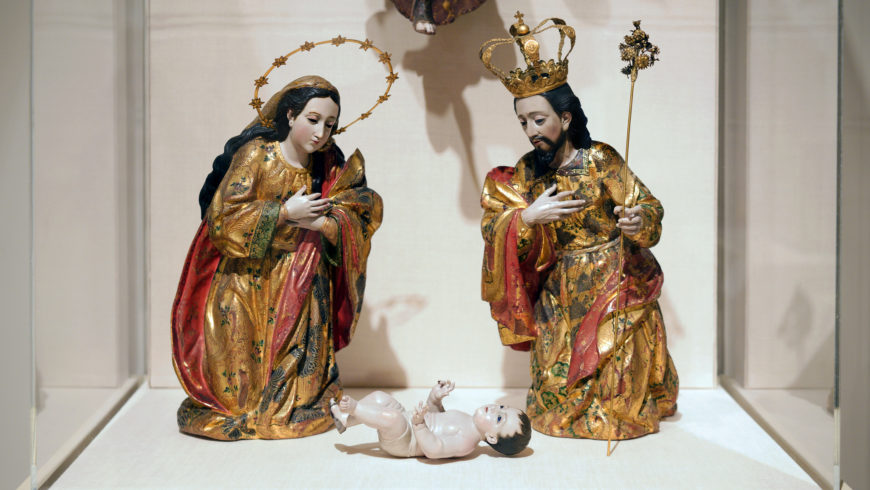
Nativity, 18th century, Guatemala, polychromed wood, gilt silver, glass, Jesus 24.4 cm, Mary 50.8 cm, Joseph 52.7 cm (The Metropolitan Museum of Art; photo: Steven Zucker, CC BY-NC-SA 2.0)
A dynamic grouping
In this Nativity group we can see how the artist used the textiles to add dynamism and volume to each figure, and the scene as a whole. Mary and Joseph are draped with extra garments that swoop around them, helping to frame their bodies and adding to their three-dimensional physicality. Gabriel’s garments flutter outwards at the bottom and, together with the long textile around his neck, give the impression of motion to match the position of his arms and legs. Even the Christ Child, who wears only swaddling clothes, gives the impression of movement with his posture.
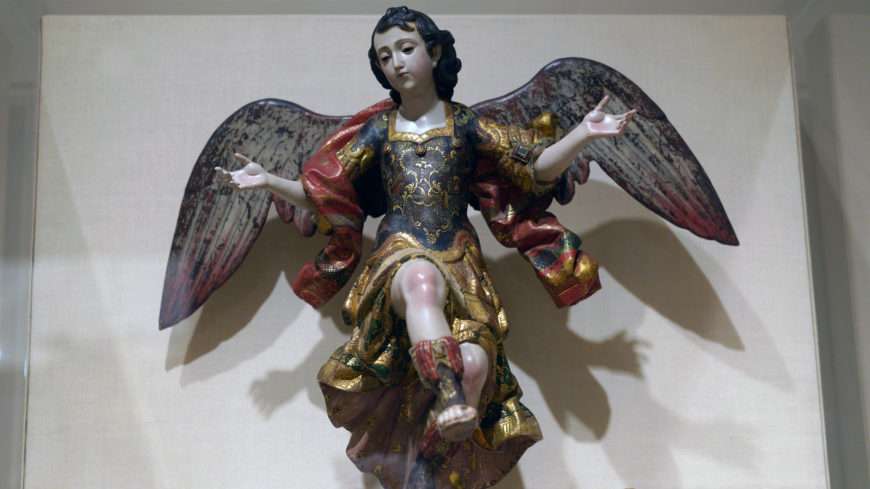
The Archangel Gabriel, from the Nativity, 18th century, Guatemala, polychromed wood, gilt silver, glass, Angel 45.7 cm (The Metropolitan Museum of Art; photo: Steven Zucker, CC BY-NC-SA 2.0)
The sense of movement and the complexity of the figures (in their composition as much as their style) is accentuated further by the gilt silver additions (such as the crown, staff, and halo) that rise into the air and the shimmering quality of the figures. The gold reflects light, and even the flesh of the figures—especially Jesus—has a pearlescent sheen. Imagine flickering candlelight reflecting across the surfaces of these sculptures.
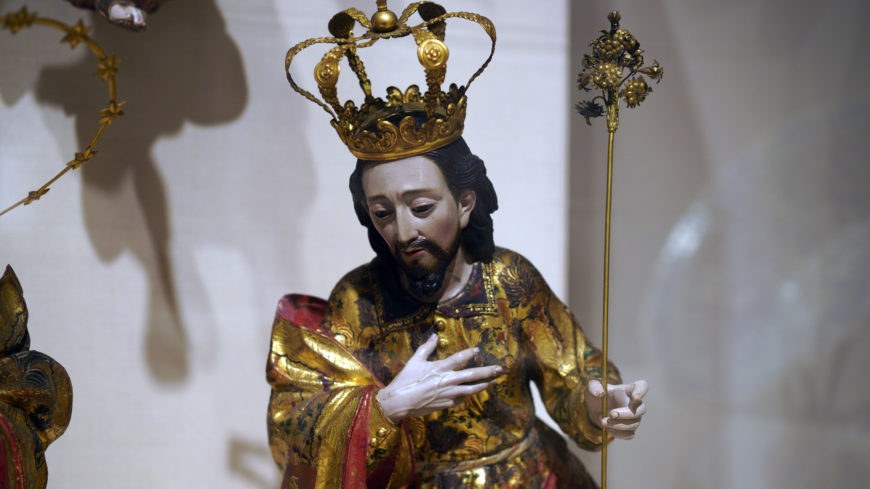
Saint Joseph, from the Nativity, 18th century, Guatemala, polychromed wood, gilt silver, glass, Joseph 52.7 cm (The Metropolitan Museum of Art; photo: Steven Zucker, CC BY-NC-SA 2.0)
The importance of Joseph
The artist shows the Holy Family as many other artists of the day did, showing Mary as an ideal, beautiful, modest woman, and Joseph as a young, handsome, and virile man. Prior to the 16th century in Europe, Joseph was often shown as elderly, and Josephine devotion was not really a priority. But in the 16th century his image transformed, with artists depicting him youthfully, as in this Nativity group. Devotion to Joseph increased, and by the seventeenth century he occupied a premier place in Spain and its viceroyalties. There are several reasons for this change, among them the suggestion by the post-Tridentine art theorist Joannes Molanus that he had to be shown this way. [1] Molanus argued that depicting Joseph young, virile, and strong made sense because he would not have been able to complete the journey to Egypt, to protect his wife and child, and to maintain his chastity if he were too elderly. Joseph became increasingly associated with the family, hard work, and conversion. In fact, he would become the patron saint of New Spain. Scholars often attribute Joseph’s elevation to the Catholic Reformation, the response to the Protestant Reformation—a time in which saints became more popular, and the Catholic Church stressed the sanctity of marriage especially and the importance of the family unit. Saints were supposed to offer models for Christians to follow; Joseph as the protective, devoted father made for what Catholics at the time felt was a strong male model.
Joseph’s visage is even modeled on Christ, with dark hair and beard, which—like other sculptures and paintings of the time—helped to cement the relationship between father and son. Joseph, as Christ’s foster father, was not related by blood to the son of God, but the visual alignment of these figures helped to communicate the idea that Joseph and Jesus were bonded, and that Joseph was a nurturing father.
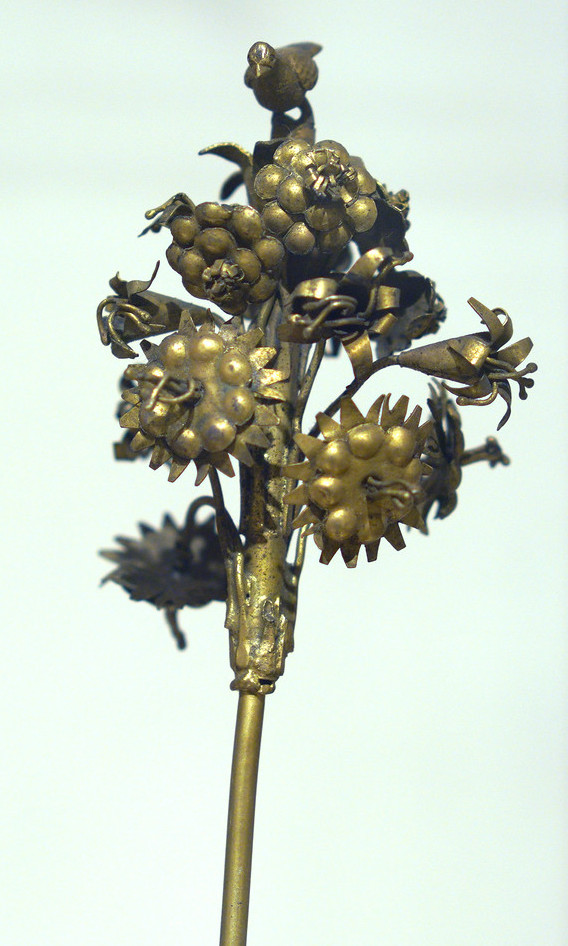
The top of Joseph’s flowering staff, from the Nativity, 18th century, Guatemala, polychromed wood, gilt silver, glass (The Metropolitan Museum of Art; photo: Steven Zucker, CC BY-NC-SA 2.0)
Another way in which artists helped to encode the idea that Joseph was young and virile was to show him accompanied by a flowering staff—such as we see here in gold. The delicate staff ends in flowers, each with carefully articulated petals, and with a dove alighting on top. The story of Joseph’s staff comes from the Gospel of Matthew and the non-biblical text called the Protoevangelion of James, both of which recount that Joseph’s staff blossomed with flowers when he was chosen among widowers by God in the Temple to wed Mary.
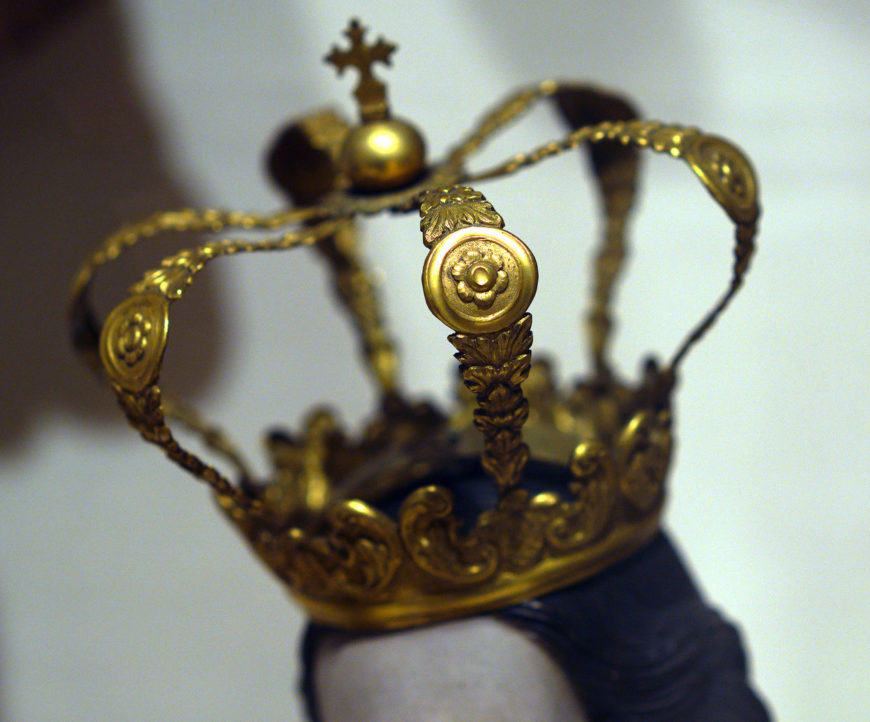
Joseph’s crown, from the Nativity, 18th century, Guatemala, polychromed wood, gilt silver, glass (The Metropolitan Museum of Art; photo: Steven Zucker, CC BY-NC-SA 2.0)
Joseph’s golden crown is also important, and alludes to his coronation in heaven after his death. Before the 16th century, Joseph was rarely depicted wearing a crown. Like the tendency to display him young in the 16th century, the decision to show him crowned happened at the same time, as he became one of the most popular saints of the Counter Reformation period. Joseph’s death is not discussed in the Gospels, and this moment in his life was elaborated on by Counter-Reformation authors who felt liberty to embellish his life story. As they recounted, after his death, Joseph was resurrected and eventually crowned by Jesus in heaven, so the crown symbolizes the saint’s exceptional role.
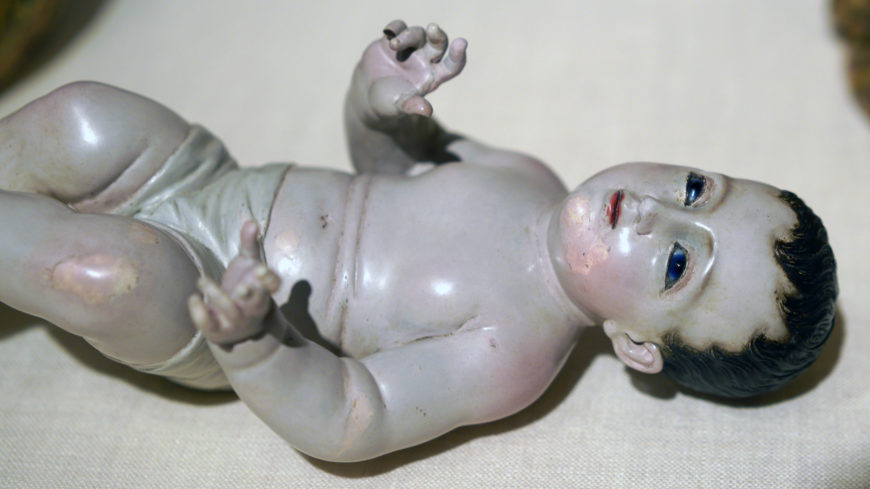
The Christ Child, from the Nativity, 18th century, Guatemala, polychromed wood, gilt silver, glass, Jesus 24.4 cm (The Metropolitan Museum of Art; photo: Steven Zucker, CC BY-NC-SA 2.0)
Reality effects and luxury materials
Polychromed, or painted, wooden sculpture was common on the Iberian Peninsula (Spain and Portugal), and the tradition came to the Americas with Spanish colonization. Creating a sculpture like the Nativity was a collaborative process, involving a sculptor, painter, and gilder. A sculptor would carve the wood to make the figures, but a painter (sometimes more than one) would then bring the figures further to life by painting the flesh tones. This process of enlivening is called encarnación, or “incarnation,” the idea that adding the flesh tones brought the figure to life. Silver or gold leaf would be applied by yet another specialist, known as a gilder.
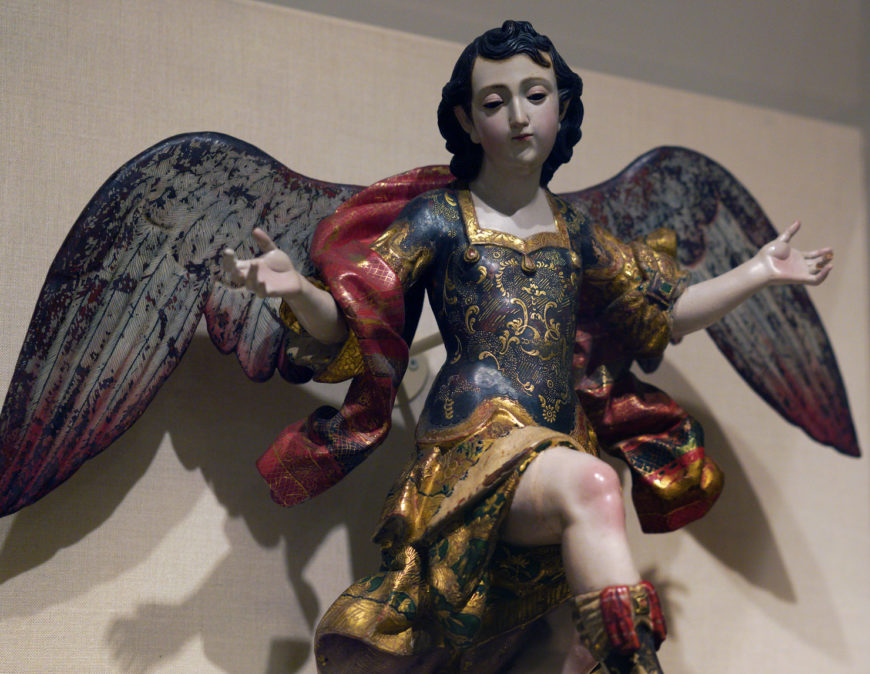
The Archangel Gabriel, from the Nativity, 18th century, Guatemala, polychromed wood, gilt silver, glass,Angel 45.7 cm (The Metropolitan Museum of Art; photo: Steven Zucker, CC BY-NC-SA 2.0)
Working in wood allowed the sculptor to create naturalistic details, some of which are subtle. Wood is more supple than a material like marble, and easier to work with than bronze. In the Nativity group, we can see the sculptor’s skill at woodworking to create reality effects. Christ’s body looks like a baby’s, with its rolls and chubby arms. Joseph’s right hand has visible veins snaking their way under his skin. The fingers of Mary and Joseph each have carefully delineated fingernails. All of these details are further enlivened by the paint. Notice the painter has even added pink tones to the figures’ cheeks and eyelids—and to Gabriel’s knees, as if blood courses through their veins. Was the angel possibly kneeling moments ago before fluttering above?
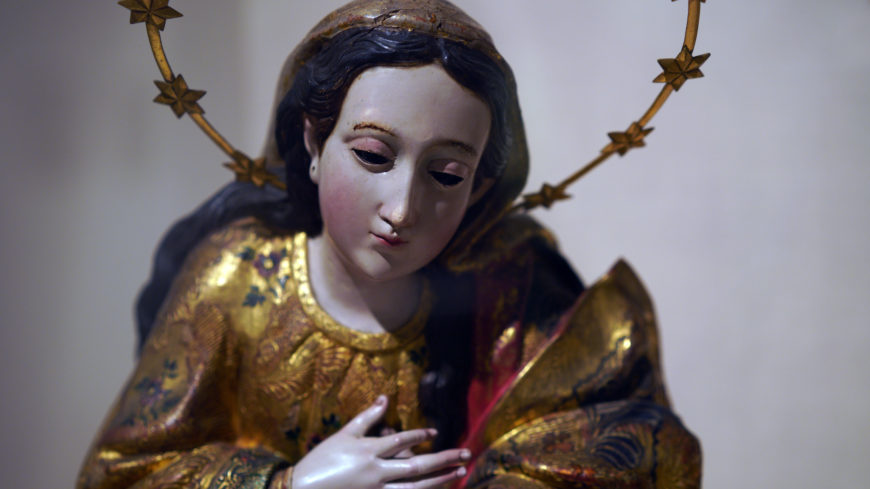
Detail of Mary, from the Nativity, 18th century, Guatemala, polychromed wood, gilt silver, glass, Mary 50.8 cm (The Metropolitan Museum of Art; photo: Steven Zucker, CC BY-NC-SA 2.0)
Polychromed wooden sculptures throughout the Iberian and Ibero-American world were often made more life-like with the addition of other materials—glass eyes, eyelashes, real hair, teeth, and additional elements that might be needed for a specific subject. The goal was to develop a more naturalistic appearance for the holy figures to aid Christian devotees in their worship. In this Nativity group, the estofado designs replicate silks and brocades. The sculptures all have glass eyes and eyelashes. Mary’s halo and Joseph’s crown are made of gilt silver—their expense not only highlighting the holy couple’s divine status, but also signifying the wealth and status of the patron. Silver and gold embellishments commonly adorned sculptures at this time.
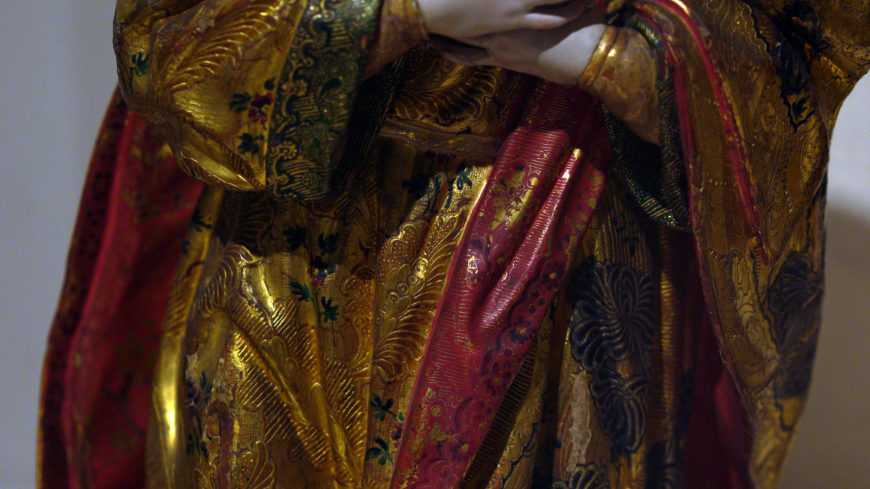
Detail of the estofado on Mary, from the Nativity, 18th century, Guatemala, polychromed wood, gilt silver, glass (The Metropolitan Museum of Art; photo: Steven Zucker, CC BY-NC-SA 2.0)
Estofado
Colonial Guatemalan sculptors are renowned for their expertise using the technique known as estofado (also called sgraffito). The word comes from estofa, meaning textile or stuff. On sculpture, it is the replication of expensive fabrics (like silk or brocade), such as we see on Mary, Joseph, and Gabriel, and which was intended to add a luxurious quality to sculptures.
How was it made? First, thin gold leaf was applied to the wood, then layers of paint added over it. Once ready, the artist would scratch away designs on the surface to reveal the gold underneath. Even if nothing was scratched away, the gold added a luminous shimmer to the paint—if the layer was thin enough, making the surface more reflective. Most common among the designs scratched to reveal the gold were flowers, foliate imagery, other elaborate designs, and even rhomboid shapes—many of which we see on the Nativity group figures.
The carving, painting, gilding, and estofado all express the careful, highly skilled work of sculptors, painters, and gilders to make even small sculptures like these four.
Worldly renown
The careful attention to details and the naturalistic modeling of the bodies all point to the expertise of sculptors, painters, and gilders working in colonial Guatemala. Even on the small-scale of these Nativity figures, we can still see why Guatemala was renowned in the viceroyalties for its sculpture.

